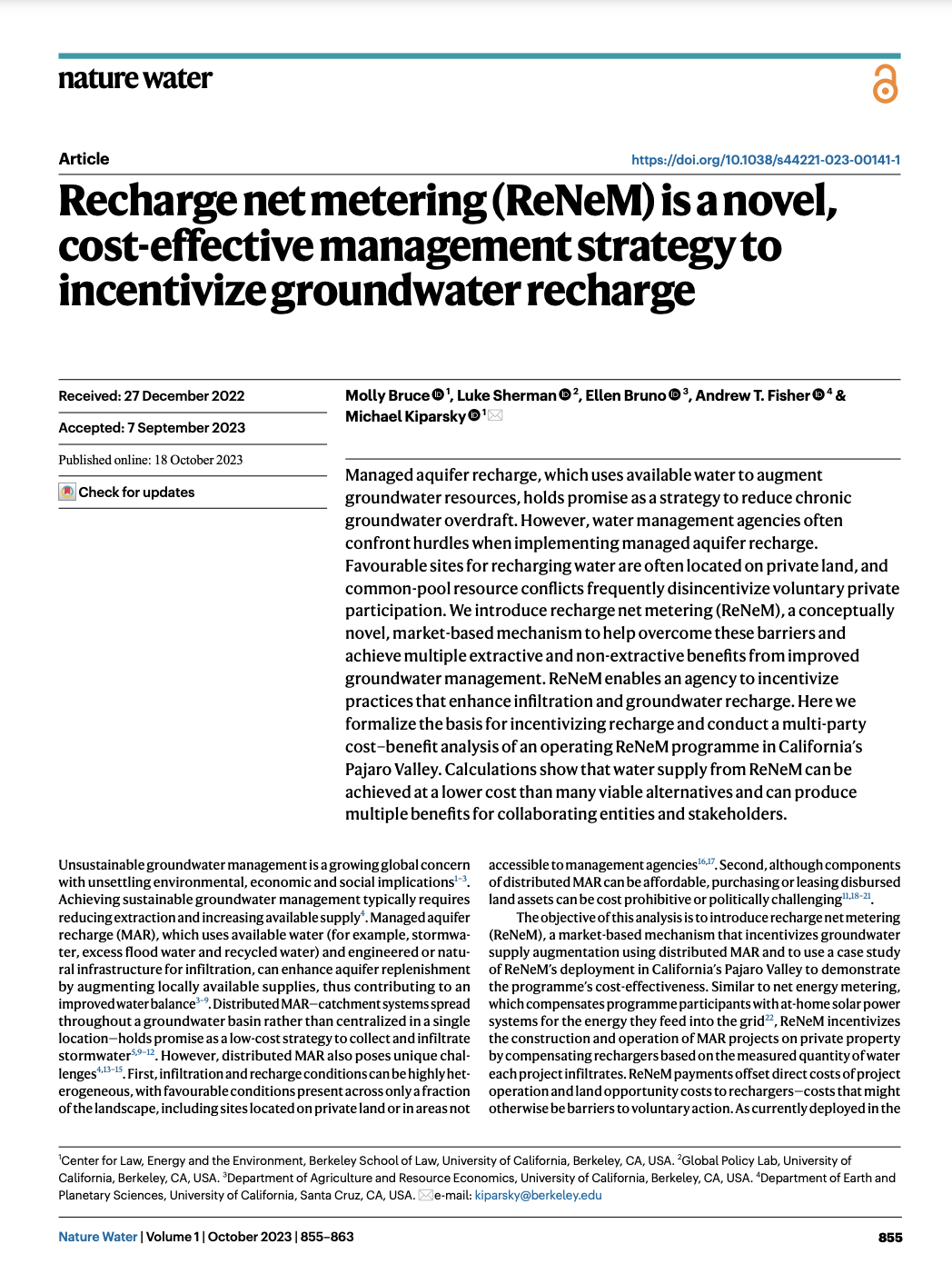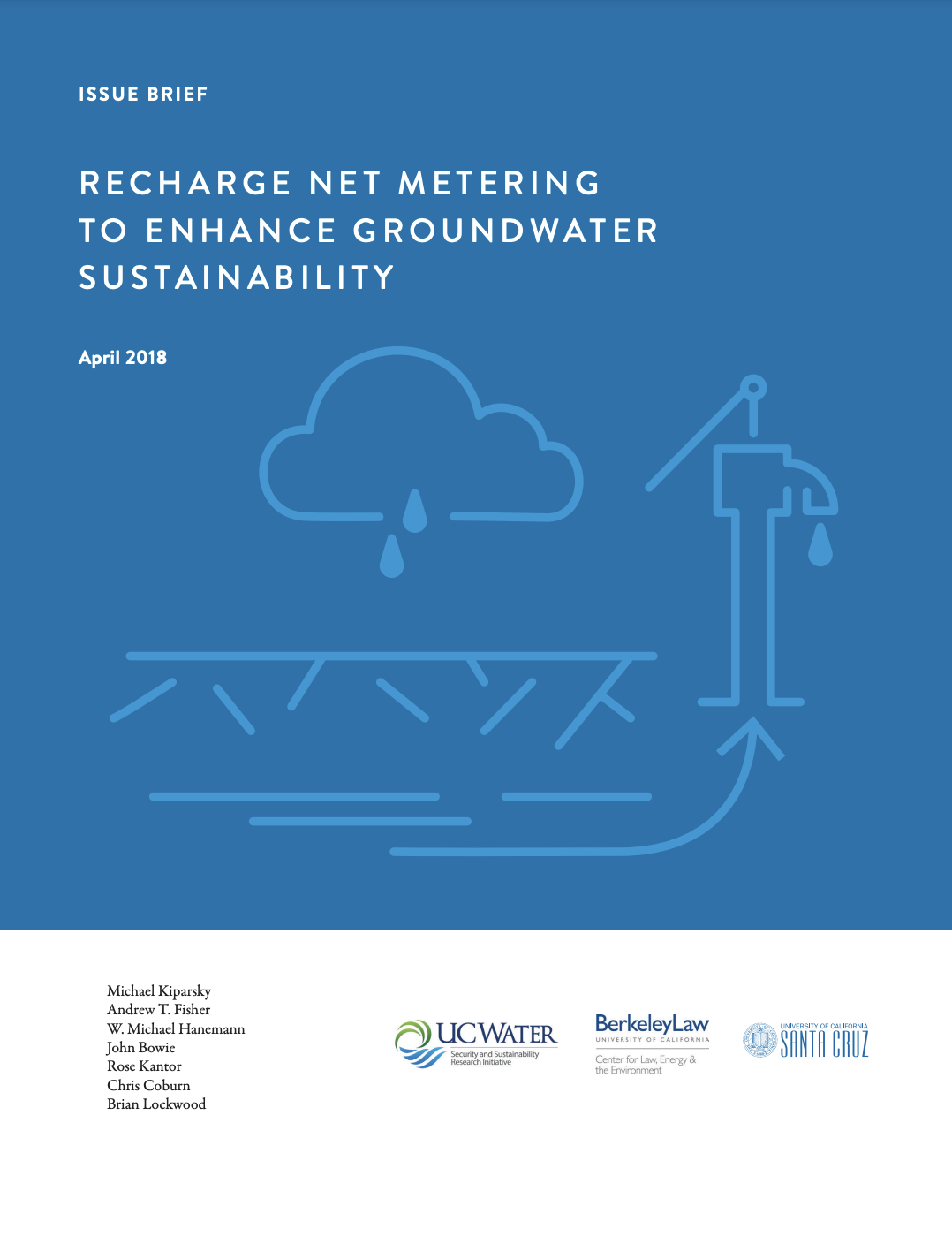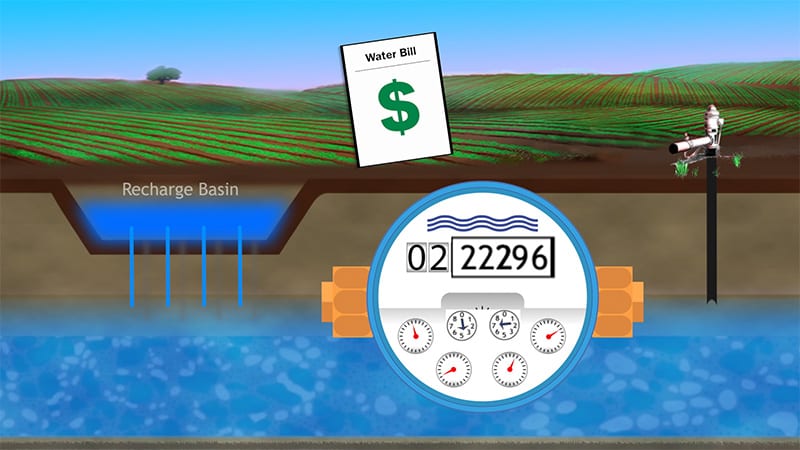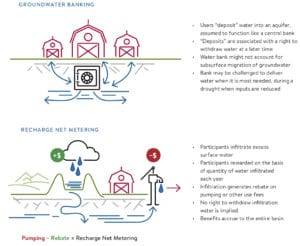Groundwater sustainability depends on balancing aquifer inflows and outflows. Extraction (pumping of groundwater, typically for human use) and recharge (inflow of water to an aquifer from the land surface and streams) are central components of this water balance.
Managed aquifer recharge (MAR) is a set of techniques used to improve groundwater conditions by routing more surface water into aquifers. MAR based on the distributed collection of stormwater (“distributed MAR”) can be accomplished at an intermediate scale, generating hundreds to thousands of acre-feet/year of infiltration benefit. A key challenge for developing distributed MAR projects lies in creating incentives that will motivate landowners, tenants, and other stakeholders to participate. Distributed MAR projects can be funded by a limited number of private participants, but public benefits may accrue more broadly. Developing and implementing policies to encourage the creation and operation of distributed MAR systems is a challenge at the frontier of groundwater management.
Recharge Net Metering (ReNeM) is a strategy that incentivizes MAR by offsetting costs incurred by landowners for operation and maintenance of water collection and infiltration systems that are placed on their land. ReNeM participants benefit directly through the rebate program; they also benefit indirectly (along with other resource users and regional aquatic systems) because MAR helps to improve and sustain the supply and quality of groundwater.
ReNeM is derived from a renewable energy incentive known as Net Energy Metering (NEM), a popular model that encourages adoption of rooftop solar panels. NEM rewards customers for their onsite generation of electricity, by charging them when they draw power from the grid (such as during evening activity), and giving them a credit on their electricity bill when power flows to the grid (such as when the sun is shining and generating excess power). In a similar way, ReNeM rebates link water use to generation of supply for other purposes.
Our Issue Brief presents a concise conceptual description of ReNeM, as well as a brief account of its first implementation as a pilot program in the Pajaro Valley of California.
Our recent case study article details the institutional conditions that enable the ReNeM incentive in the Pajaro Valley.
Further research is ongoing, and additional research products will be posted on this page as they are finalized.
Download the Issue Brief:
Recharge Net Metering to Enhance Groundwater Sustainability (April 2018)
Download the Pajaro Valley case study:
Incentivizing Groundwater Recharge in the Pajaro Valley Through Recharge Net Metering (ReNeM) (April 2021)
Q&A in Western Water:
Novel Effort to Aid Groundwater on California’s Central Coast Could Help Other Depleted Basins (May 2018)
For More Information:
Contact Mike Kiparsky, Director, Wheeler Water Institute, Center for Law, Energy & the Environment
This project is part of the UC Water Security and Sustainability Initiative and supported by the University of California Office of the President
Authors & Affiliations
Michael Kiparsky, Director of the Wheeler Water Institute, Center for Law, Energy & the Environment, UC Berkeley School of Law
Andrew T. Fisher, Professor, Earth & Planetary Sciences, University of California, Santa Cruz
Michael Hanemann, Chancellor’s Professor and Professor of Environmental and Resource Economics, Department of Agriculture and Resource Economics, UC Berkeley
John Bowie, Research Fellow at the Wheeler Water Institute at the Center for Law, Energy & the Environment, UC Berkeley School of Law (fomer); Senior Associate, Kearns & West (current)
Rose Kantor, Postdoctoral Scholar, Department of Civil and Environmental Engineering, UC Berkeley
Chris Coburn, Executive Director, Resource Conservation District of Santa Cruz County
Brian Lockwood, General Manager, Pajaro Valley Water Management Agency
Related Reading
Beganskas, Sarah, and Andrew T. Fisher. “Coupling distributed stormwater collection and managed aquifer recharge: Field application and implications.” Journal of Environmental Management 200 (2017): 366-379.
California Department of Water Resources. California Water Plan Update. Available at: https://www.water.ca.gov/Programs/California-Water-Plan.
Fisher, Andrew T. “Groundwater provides and receives hydrologic system services.” Groundwater 53.5 (2015): 671-672.
Green Nylen, Nell, Michael Kiparsky, Kelly Archer, Kurt Schnier, and Holly Doremus. 2017. Trading Sustainably: Critical Considerations for Local Groundwater Markets Under the Sustainable Groundwater Management Act. Center for Law, Energy & the Environment, UC Berkeley School of Law, Berkeley, CA. 90 pp. law.berkeley.edu/trading-sustainably
Kiparsky, Michael, Dave Owen, Nell Green Nylen, Juliet Christian-Smith, Barbara Cosens, Holly Doremus, Andrew Fisher, and Anita Milman. 2016. Designing Effective Groundwater Sustainability Agencies: Criteria for Evaluation of Local Governance Options. Center for Law, Energy & the Environment, U.C. Berkeley School of Law. law.berkeley.edu/groundwater-governance-criteria
Kiparsky, Michael. “Unanswered questions for implementation of the Sustainable Groundwater Management Act.” California Agriculture 70.4 (2016): 165-168.
Russo, Tess A., Andrew T. Fisher, and Brian S. Lockwood. “Assessment of managed aquifer recharge site suitability using a GIS and modeling.” Groundwater 53.3 (2015): 389-400.



